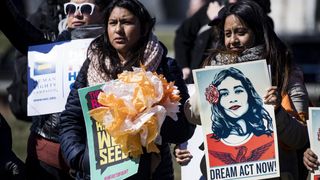From the Mexican border wall to refugee swap deals from Manus and Nauru, immigration has been a recurring point of tension during the Trump administration. But debate over a group of between 700,000-800,000 immigrants already residing in the United States has been the most contentious.
Who are the DREAMers?
Taking their name from a failed 2001 Congress Bill – the DREAM, or Development, Relief, and Education for Alien Minors Act – the DREAMers are a group of immigrants whose parents brought them into the United States without a permanent visa. The Dream Act made the case that because of their age, the children should not be held responsible for the decision to migrate, or overstay a visa, and should be offered a path to citizenship.
To qualify for the act, immigrants had to have arrived in the United States before the age of 16. They must have been currently enrolled in or have completed high school or a General Education Development (GED) certificate, or have been honourably discharged from the armed service. Candidates who were considered to be of ‘unsound moral character’ or to have committed a crime were excluded.
The Dream Act made the case that because of their age, the children should not be held responsible for the decision to migrate, and should be offered a path to citizenship.
The bill never gained enough traction on the floor of the Congress to pass, despite several revivals and one filibuster over the following decade.
Today, the majority of those who fall within the bounds of the failed legislative act are between 16-35 years of age.
Although it is estimated that there were up to 1.8 million people who could qualify for the program in 2012, demographic estimates of the DREAMers are based on the information from those who voluntarily signed up for the DACA program since its inception in the same year.
This number equates to roughly 800,000 people. More than 618,000 are from Mexico, but there is a wide range of nationalities that comprise the remainder, from as far away as South Korea, India and the Philippines.
These immigrants live in every US state, but are most concentrated in California and Texas, where collectively about 350,000 live.
What is DACA?
In the absence of a consensus in Congress, President Barack Obama used his executive powers to institute DACA, or the Deferred Action for Childhood Arrivals.
This gave quasi-legal status to those who met the criteria for the original DREAM Act, allowing them to work and study within the United States for a period of two years before having to renew their deferral from deportation.
As it is an executive action and not legislation, DACA does not provide a path to citizenship. When announcing the program, President Obama described it as “a temporary stopgap measure that lets us focus our resources wisely while giving a degree of relief and hope to talented, driven, patriotic young people”.
The Trump administration came into office in 2017 with the permanent status of the DREAMers still unresolved
As such the DACA was only ever in lieu of a concrete legislative measure giving full legal status to the DREAMers.
There were subsequent further and failed attempts to encompass DREAMers in an immigration package, including one that passed the Senate but failed in the House.
So it was that having campaigned hard on a promise to “immediately terminate” DACA, the Trump administration came into office in 2017 with the permanent status of the DREAMers still unresolved.
What is Trump seeking to do with DACA?
Extend it, and leverage it, and end it. In short, he hasn't shown any consistency.
Following his election, the president’s tone shifted on the program, saying that those covered by it are “terrific people” and that his administration was going to “show great heart”. By all accounts it appeared DACA was a low priority.
This seemed to be confirmed in June 2017 when the Department of Homeland Security (DHS) announced plans to end another Obama-era policy titled Deferred Action for Parents of Americans and Lawful Permanent Residents (DAPA). This program was stalled in the courts and never really took effect, but DHS made clear on its website its rescinding was not to be confused with the end of DACA.
Congress had just six months to do what it had been unable to do for the previous 16 years: find a consensus on the DREAM Act. And again, it failed.
But that same month nine state attorneys general and one governor vowed to sue the administration for executive overreach unless the program was scrapped. This renewed the pressure on the program came to a head in September, and Trump’s Attorney General Jeff Sessions announced that DACA would expire in March 2018.
Ostensibly this gave Congress just six months to do what it had been unable to do for the previous 16 years: find a consensus on the DREAM Act. And again, it failed.
What followed was messy. Republicans have never really liked DACA and its links to Obama – and along with the White House they used the opportunity to tie its permanent legislation to border security and other immigration measures, including funding for the border wall and sweeping reductions to legal immigration.
This created a stalemate that saw the March 5 deadline reached.
DACA is "dead"? What happens now?
Just an hour after wishing Americans a happy Easter on the 1st of April 2018, the president unleashed a confusing Twitter tirade against DACA.
These big flows of people are all trying to take advantage of DACA. They want in on the act!
— Donald J. Trump (@realDonaldTrump) April 1, 2018
DACA is dead because the Democrats didn’t care or act, and now everyone wants to get onto the DACA bandwagon... No longer works. Must build Wall and secure our borders with proper Border legislation. Democrats want No Borders, hence drugs and crime!
— Donald J. Trump (@realDonaldTrump) April 2, 2018
These Tweets are misleading for two reasons. The first is that newcomers can't "take advantage of DACA". The prospect of DACA protection for new immigrants ended on September 5, 2017 when Jeff Sessions announced the impending expiration of the program.
Secondly, DACA isn't dead. Even though the deadline was passed, in the week preceding the Supreme Court refused to hear an appeal from the White House to decide whether the administration could immediately terminate the program. This meant that DACA renewals had to be continued while lower courts took the necessary time to consider challenges to its cessation.
Trump also urged Republicans to "go nuclear" and to thus remove the filibuster and reduce the 60 vote supermajority requirement to a 50 vote majority to get immigration legislation passed. But so long as the White House’s ‘wish-list’ for a deal remains in play, it is highly unlikely that even this will suffice. The president's preferred immigration bill was voted on in March and only swayed 39 senators.
Until this Tweetstorm, the Supreme Court ruling as well as the focus on guns following the Stoneman Douglass school shooting had taken the impetus away from legislators' minds and seemed to ensure the prospects for the DREAMers would be in the air until the DACA issue worked its way through the lower courts.
This could take several months, but once this process is complete, and if it finds that the case has merit – no guarantee – there is little to stop the program being immediately terminated. In the meantime, presidential Tweets will have no bearing on the legal status of DREAMers.




.jpg?rect=0,80,3000,1989&fp-x=0.5&fp-y=0.44772296905517583&w=320&h=212&fit=crop&crop=focalpoint&auto=format)

